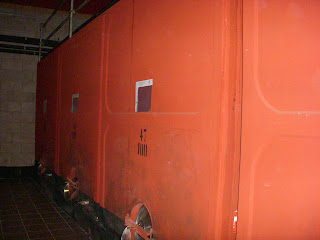








In 1974 the Falvo brothers, owners of the vineyards in the district of Cortona, took over Avignonesi and refounded it investing greatly in viniculture, selecting the local varieties and introducing classical ones such as Chardonnay, Sauvignon Blanc, Cabernet Sauvignon, Merlot, Pinot Noir.
Please excuse my rough notes as we were standing in the vineyards as it began to rain....
Avignonesi houses an agricultural school on the property
The winery and vineyards were originally in Montepulciano but the operation was moved in 1889 to Cortona to allow the business to grow.
Currently there are 4 estates planted in the DOCG of Montepulciano and the DOC of Cortona
The Falvo brothers played the primary role in helping elevate Cortona to a DOC in 1998.
Cortona as a DOC allows for a wide variety of different grape to be produced
Vineyards are planted in a spacing method that is called Aberello (meaning small tree, the same formation that roman solders line-up in): there are no wires between the wines as the vines are planted in hexagons. Every 60 degrees there is another tree planted which allows for tight spacing and a good amount of sun exposure. This causes the root systems to go deep into the subsoil. Average spacing is 7000 plants per hectare. Each vine produces only two-three bunches.
Organic farming is employed unless there are serious problems in the vineyards where as chemicals will be used to save fruit.
Students from the Florence Viticulture school come here to study and experiment.
Montipulciano could be divided into 3 main sub zones based primarily on elevation. The higher the elevation the more alluvial soil will be found in the vineyard. The lower the elevation the more clay which holds water.
Avignonesi being on the south side of town tends to have more clay. Corta alla Flora is at a higher elevation.
VIN SANTO (translated to english.....so fucking good!)
In a good year Avignonesi will only produce 1300 375ml of their vin santo!
Most producers age their Vin Santo on mats drying for 2 months. Avignonesi has an historic drying room which they lay out the grapes in and dry the wines for 6 months minimum.
Vin Santo is more about the yeast used than the grapes used.
Vin Santo Grapes are then aged in a hot room inside tiny barriques for 10 yrs! During the aging process about half of all the juice is lost. After the Vin Santo is finished a bottle can be open for an extremely long period of time as the juice is already Oxed.
1990 Vin Santo from Avignonesi received 100 points from the wine spectator which was only the second time a Italian wine had done that at the time.
Heavy mold in the cellar eliminates vinegar bacterias and seals the barrels from the air.
Before you ever produce VNdM you must get the plants from the Italian Government and declare how much you intend to produce
VNdM
85% Prunolo Gentile
10% Caninolo
5% Malmiolo
I will spare you my tasting notes but
THE DESIDERIO Merlot KICKS ASS!
or better said by JOE BEST "A smart man's Petrus"








































